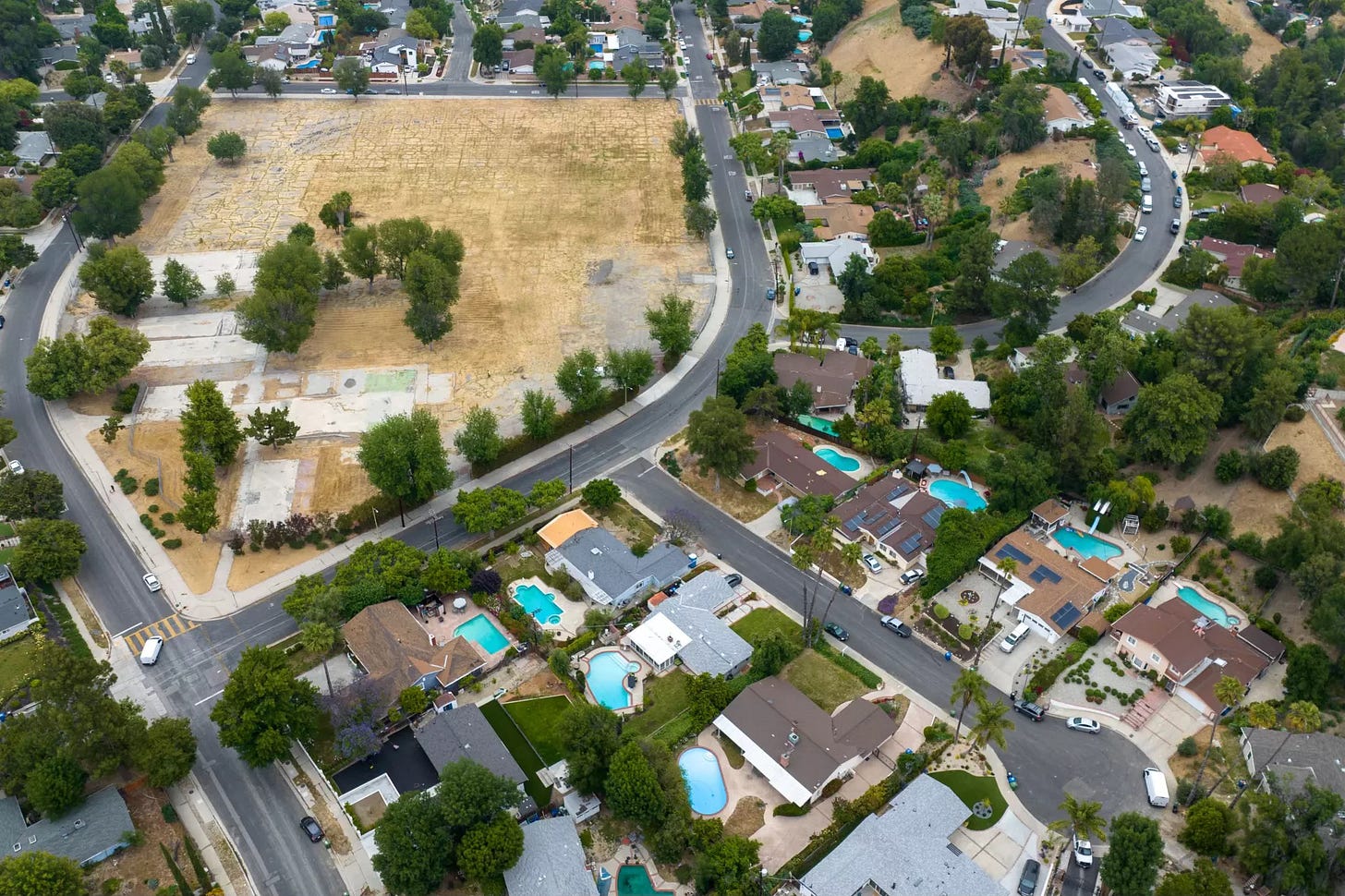Throughout my career, I have had the opportunity to visit a wide variety of communities across the country – from small towns and suburban communities to our biggest cities. These visits have made me realize that our inability to maintain an adequate supply of affordable housing is no longer just an urban story. In fact, housing supply shortfalls in our rural communities are expanding three times faster than our cities.
Historically, it was easy to build affordable housing in rural communities because land was literally "dirt cheap”.1 Today, the cost of land for housing development is expensive everywhere and our inability to provide an adequate supply of affordable housing has become a nationwide problem.
(This is what public land that could be used for housing development looks like)
Land, Land Everywhere but Not Enough to Build
Land costs are high because we are running out of readily buildable land. This might seem counterintuitive, given our nation's vast expanse, but it's true. Parcels that are entitled, shovel-ready, infrastructure-served, and located in or near existing communities, job centers, and amenities have become vanishingly scarce.
The cost of this scarcity is profound because it makes every parcel that is buildable that much more expensive. Take, for example, Menlo Park, California, where land costs have exploded—from the cost of land representing 15% of total value for a single-family property in the 1970s to an eye-watering 90% today.
To bring these costs down, we must streamline the highly discretionary approval processes that have made land entitlements too unpredictable, costly, and slow. At the same time, we also need to make more land available for housing development. That is why a growing consensus of elected officials from across the political spectrum are getting behind measures that will unlock more public land for housing development.
Public Lands Are Everywhere
When most people think of our publicly owned lands, they think of remote places like Yellowstone, Mount Rushmore, or the Grand Canyon. What often goes unnoticed is the significant amount of underutilized public land that exists within communities all across the United States. According to the Lincoln Institute of Land Policy's Center for Geospatial Solutions, there are nearly 276,000 acres of publicly owned land located near transportation, job centers, and existing infrastructure.
By making better use of the public lands that exist within our communities, we could create millions of new affordable homes, unleash hundreds of billions of dollars in untapped economic potential, and generate lasting revenue streams to fund essential public services without additional taxes.
Public Lands Are Already Being Used - Just Not for Housing
Opening public lands for housing development does not mean that we should be selling public land to the highest bidder. Instead, we should make it easier for the government to enter into long-term ground lease agreements that reduce land acquisition costs for affordable housing developers and generate stable, long-term revenue streams for taxpayers.
A nationwide approach like this is not unprecedented. In fact, the United States has a long history of using lease agreements with the private sector to untap the economic potential of our public lands. We lease federal lands at below market rates to energy companies to drill for oil and gas. We lease federal lands at below market rates to ranchers to feed their cattle. And, we lease federal lands to mining companies that enable them to extract our gold, silver, uranium, and copper for free.2
Some communities are already experimenting with a similar approach for affordable housing and finding success. In Texas, the city of Dallas is making long-term lease agreements for public land available to housing developers who agree to increase the supply of long-term affordable housing units. This has enabled the city to retain ownership of its land and create more affordable housing without relying on additional public subsidies.
There is no need to reinvent the wheel. We just need to make it easier to do what Dallas does at scale.
Making it Scale Requires a National Approach
Efficiently opening our 267,000 acres of public land suitable for housing development in communities across the country at scale will require a coordinated national effort. Recently, former Congressman Ben McAdams and researcher Tracy Hadden Loh at the Brookings Institution, came up with a great idea. They believe that we should create a dedicated federal entity tasked specifically with putting these valuable public assets to work in the most efficient and cost effective manner possible. Using their idea as a starting point, we should establish a national housing production office with two primary responsibilities:
Creating a National Public Lands Database: To make the process of unlocking our public lands more efficient, ensuring that everyone has access to the same information is key. A national housing production office would allow for the creation of a comprehensive inventory of publicly owned land nationwide, detailing parcel locations, ownership, current uses, and proximity to infrastructure and amenities. This public inventory of land would provide affordable housing developers with the data they need to identify the public lands that are most suitable for development and begin working with the state, local or federal government.
Streamlining the Application and Ground Lease Process: To ensure rapid, high-quality outcome and ensure that leases can be negotiated and approved quickly, a national housing production office would establish standard guidelines and documents to help streamline the lease approval process for affordable housing developers. Simply developing common ground lease and application templates would reduce administrative costs for local governments, expedite the approval process, and enable successful local programs to work at scale across the country.
An Invitation to Collaborate and Get Started
Admittedly, opening our public lands to affordable housing development is a big idea. But the concept is not new. We leverage public lands for public benefit every day. And if we can use our public lands to put more gasoline in cars and more hamburgers on grills, then there is no reason we cannot use our public lands to make housing more affordable for more families across the United States.
I believe this idea holds a great deal of promise. But it will require careful planning and broad collaboration. We must be transparent and accountable every step of the way.
I invite policymakers, experts, community leaders, and anyone passionate about solving our housing crisis to engage, critique, and refine this idea. Do you see something promising here? Or something I've overlooked?
I welcome your thoughts, questions, and criticisms. Let’s start a dialogue—reach out via email or LinkedIn. Together, we can shape this ambitious vision into practical, transformative solutions.
Our Guest Contributor this week is Mike Kingsella. Mike is the Founder & CEO of Up for Growth, a Washington, D.C.–based policy association dedicated to solving America’s housing shortage.
The term “dirt cheap” originated in the early 1800’s because back then dirt was cheap.
[Editors note: Oddly enough, before people used the term “dirt cheap” they would often use the phrase “dog cheap”. Neither Mike nor I know what people were thinking back then.]







Great article. Public - private Investment partnerships are a great means to solving the affordable housing crisis.